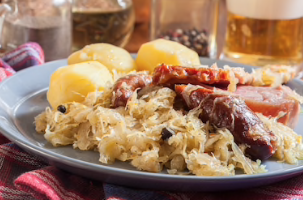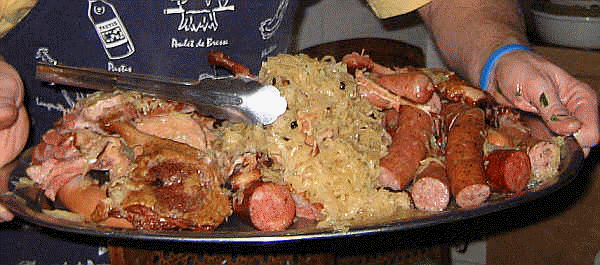Sauerkraut
- rosemarydearman1
- Sep 29, 2018
- 4 min read
"It's beyond easy to make, it requires very little special equipment, and the results are dependably delicious." Emma Christensen - Kitchn

I'm cooking David a sauerkraut meal tomorrow - I think it will be pork chops with sauerkraut from my Central European Cooking book that I mentioned yesterday. Or maybe Nigel Slater's version of the same thing (on the right below). Or maybe the Transylvanian goulash - but then we did have goulash the other day and I did buy some lovely pork chops at the market the last time I went, so I think the pork chops.
I think I'll stick with my cookbook version because my aim in doing the David's special meal thing was really to use my cookbook collection more than I do. Tempted by the zucchini in Nigel Slater's though. But then again he really only uses a tiny bit of sauerkraut and the aim is to feature the sauerkraut.
Sauerkraut is an ancient food of course. Cato and Columella - Romans both of them - mention it. It's a fermented food and fermentation is as old as food going off - sort of. And I guess food went off a lot in ancient times. The Chinese brought it to Europe it is said, but they used rice wine to ferment the cabbage. The Europeans changed it to the much simpler salt. For that is all you need to make sauerkraut - cabbage, salt, a big jar and time - and not really too much of that - the longer you ferment it the sourer it gets - a couple of weeks seems to be the most often quoted. I shall be using shop bought sauerkraut - though from Aldi which I somehow think of having more 'authentic' sauerkraut. But now that I have been looking into this I think that really I should be making some of my own. I also should be using it more often because besides being delicious - yes I love it - and so does David - it is very trendily good for you - fermented foods are very definitely 'in'.
We think of it as Central and Eastern European but it is French too. In France they call it choucroute and choucroute garnie was the very first real French food that I saw in a restaurant. The night I arrived in France for the first time to stay with my first French exchange friend, we went out for a meal in Paris to an Alsatian restaurant called Aux Armes de Colmar. Colmar is a town in Alsace. The waiters were bearing huge platters of choucroute garnie through the restaurant. I can see them still. We didn't eat that because I think you had to be several people to order it. They didn't do it for just one person. I make it occasionally but you need a crowd to feed really because you should include a large variety of different sausages, and meats. And Elizabeth David or Mastering the Art of French Cooking are the best sources for a recipe.
But you can do so much more with sauerkraut:
"Sauerkraut is tolerant, for it seems to be a well of contradictions. Not that it would preach a gastronomic neutrality that would endure all heresies. It rejects dogmatism and approves of individual tastes. It forms a marvelous combination with numerous spices, odors, or spirits: juniper berries, coriander seeds, peppercorns, cranberries, Reinette apples, stock, and wine; it even welcomes flakes of yeast or leftover Gruyère since it accepts being prepared au gratin. Its flavor sustains various potato dishes: boiled in their skins, crisps (potato chips), braised, sautéed, grilled, or simply cooked in water. It adopts many sorts of fat, including lard, butter, goose fat, or roast dripping. The variety of meats to which it consents is infinite: sausages of all kinds, such as knackwurst, white sausage, Lorraine, Montbeliard, chipolata, black pudding, hams, smoked or salted bacon, quenelles, pickled and smoked pork, goose, pheasant, etc. It makes excuses for red wine, although it has a weakness for beer and lets itself be spoilt by white wine. Each stomach may find its own happiness in it." Julien Freund, Director of the Institute of Sociology in Strasbourg, (Les Saisons d'Alsace)
I also remember travelling through Germany on the way to Yugoslavia and stopping in autobahn cafés where we would eat sausages and sauerkraut. In fact this may have been where I first ate it. We certainly never had it at home, and I don't think either of my French families cooked it. I do love it - it's piquant and somehow refreshing. And - last personal memory of sauerkraut - my first born son, whilst still a baby would eat food that I had cooked for us, mashed through the mouli to the right texture. Once I tried him with sauerkraut and he ate it! Not sure whether he would eat it now. Don't think I have tried it. I should some time - maybe next time I have the whole lot here.
I now see that I really should try to make my own as all the sites with recipes - and there are many - say that it tastes so much better.
"As a novice home "krautmaker", it’s not just the tart flavour that’s addictive. Played out on your own kitchen bench, the transition from raw vegetable to preserved product is fascinating, inspiring the possibility of new flavours, along with a growing sense of confidence. Green apple and caraway seeds? Carrot and grated ginger? Virtually any vegetable, fruit or spice can be experimented with, harnessing a centuries-old and uncannily simple process for an entirely bespoke creation." Alecia Wood - The Guardian
And just to prove that you can experiment here are two stylish versions - one from Pete Evans and one from Donna Hay, who uses red cabbage and beetroot in her version. The Pete Evans one had some kind of bought starter in it as well - which put me off, but he's one of those messianic paleo people isn't he? The picture is pretty though.
For a good basic recipe that even includes a video go to the Kitchn website. Then start adding things and experimenting. Donna Hay also has a virtually identical recipe.
Interestingly Delia Smith doesn't seem to go for sauerkraut - though Jamie does.






















Comments